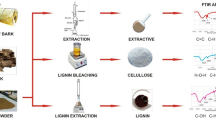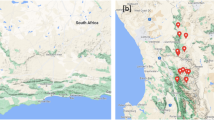Abstract
Several studies have shown that the heartwood of Prosopis juliflora contains high amounts of a naturally rare flavan-3-ol compound identified as 2-(3,4-dihydroxyphenyl)chromane-3,7,8-triol otherwise known as (−)-mesquitol (1). It is known to possess strong antioxidant properties, which may be of valuable interest for further valorization. However, no data exists so far showing the variations of its abundance depending on the different geographic habitats of the tree, the age and the different parts of the tree stem. The variability of flavan-3-ols depending on the geographical area and intra-specific variability within P. juliflora trees from Kenya was addressed in this substantive study. The study was done using wood extracts from three different counties in Kenya (Baringo, Garissa and Turkana Counties). Wood samples were separated into two categories of ages; small trees, aged less than 4 years and the big trees, aged more than 8 years. Each sample was divided into five different parts, which included the bark, sapwood, knot wood, heartwood and the pith. Serial extractions were done by the Dionex accelerated solvent extractor using four solvents in increasing polarity (dichloromethane, acetone, toluene: ethanol (2:1 v/v) and finally water). Gas chromatographic analysis coupled to mass spectrometry was employed to identify the different compounds present in the extracts. LC–MS/MS method was thereafter developed and used to confirm the identity and quantify the amounts of mesquitol present. Two other flavan-3-ols identified and quantified included catechin (2) and 4′-O-methylgallocatechin (3). A systematic study on the mass spectra and the observed fragmentations of the flavonoids showed that mesquitol compound is the most abundant compound in P. juliflora with high amounts being found in the heartwood and pith of the acetonic extract (47–72%). Mesquitol abundance was also found to vary depending on the age of the tree and on the geographical areas.




Similar content being viewed by others
References
Azam MM, Tewari JC, Singh Y, Roy MM (2011) Prosopis juliflora, a rich source of antioxidant product. Central Arid Zone Research Institute, Jodhpur
Bokrezion H (2008) The ecological and socio-economic role of Prosopis juliflora in Eritrea. Academic Dissertation, Johannes Gutenberg-Universität Mainz, Mainz (PhD report)
Braicu C, Ladomery MR, Chedea V, Irimie A (2013) The relationship between structure and biological actions of green tea catechins. J. Food Chem 141:3282–3289
Kalsi PS (2004) Spectroscopy of organic compounds, 6th edn. New Age International Publishers, New Delhi, pp 45–51
Lakshmibai R, Amirtham D, Radhika S (2015) Preliminary phytochemical analysis and antioxidant activities of Prosopis juliflora and Mimosa pudica leaves. Int J Sci Eng Technol Res 04(30):5766–5770
Muturi GM (2012) Ecological impacts of Prosopis invasion in Riverine Forests of Kenya. Academic Dissertation, Wageningen University (PhD report)
Mwangi E, Swallow B (2008) Prosopis juliflora invasion and rural livelihoods in the Lake Baringo area of Kenya. Conserv Soc 6(2):130–140
Odero MP, Munyendo WL, Kiprop AK (2017) Quantitative analysis of the flavonoid mesquitol in the medicinal plant Prosopis juliflora with seasonal variations in Marigat, Baringo County-Kenya. Sci J Anal Chem 5(6):107–112. https://doi.org/10.11648/j.sjac.20170506.16
Pasiecznik NM, Felker P, Harris PJ, Harsh L, Cruz G, Tewari JC, Maldonado LJ (2001) The ‘Prosopis juliflora’–’Prosopis pallida’ complex: a monograph, vol 172. HDRA, Coventry
Ramesh KB (2017) Application of HPLC and ESI-MS techniques in the analysis of phenolic acids and flavonoids from green leafy vegetables (GLVs). J Pharm Anal 7(6):349–364
Raven PH, Evert RF, Eichhorn SE (2005) “Chapter 24”. Biology of plants, 7th edn. Freeman, New York, pp 528–546
Shackleton RT, Le Maitre DC, Pasiecznik NM, Richardson DM (2014) Prosopis: a global assessment of the biogeography, benefits, impacts and management of one of the world’s worst woody invasive plant taxa. AoB PLANTS 6:plu027. https://doi-org.bases-doc.univ-lorraine.fr/10.1093/aobpla/plu027
Sirmah PK (2009) Valorisation du Prosopis juliflora comme alternative à la diminution des ressources forestières au Kenya. (Towards valorisation of Prosopis juliflora as an alternative to the declining wood resource in Kenya) (in French). Academic dissertation, Université de Lorraine (PhD report)
Sirmah P, Muisu F, Mburu F, Dumarçay S, Gérardin P (2008) Evaluation of Prosopis juliflora properties as an alternative to wood shortage in Kenya. Bois et forêts des tropiques 298(4):25–35
Sirmah P, Dumarçay S, Masson E, Gérardin P (2009) Unusual amount of (−)-mesquitol from the heartwood of Prosopis juliflora. Nat Prod Res 23(2):183–189
Sirmah P, Mburu F, Iaych K, Dumarçay S, Gérardin P (2011) Potential antioxidant compounds from different parts of Prosopis juliflora. J Trop For Sci 23(2):187–195
Acknowledgements
This study was financially supported by the Pamoja PHC program project Curien Hubert; the French Embassy in Kenya; the Africa Centre of Excellence in Phytochemicals, Textile and Renewable energy (ACEII-PTRE) at Moi University, Kenya; and the French National Research Agency (ANR), which supports Lermab, the laboratory where the study was undertaken, by a grant as part of the “Investissements d’Avenir” program (ANR-11-LABX-0002-01, Lab of Excellence ARBRE).
Author information
Authors and Affiliations
Corresponding author
Ethics declarations
Conflict of interest
On behalf of all authors, the corresponding author states that there is no conflict of interest.
Additional information
Publisher's Note
Springer Nature remains neutral with regard to jurisdictional claims in published maps and institutional affiliations.
Rights and permissions
About this article
Cite this article
Chepkwony, S.C., Dumarçay, S., Chapuis, H. et al. Geographic and intraspecific variability of mesquitol amounts in Prosopis juliflora trees from Kenya. Eur. J. Wood Prod. 78, 801–809 (2020). https://doi.org/10.1007/s00107-020-01535-8
Received:
Published:
Issue Date:
DOI: https://doi.org/10.1007/s00107-020-01535-8




